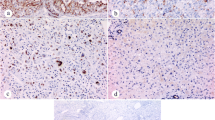Abstract
The purpose of this study is to investigate if the EGFR-Stat3 signal pathway contributes to the carcinogenesis of hepatoma in rats. Hepatoma was induced in rats by 3′Me-DAB as a model. EGFR, TGFα, Stat3, p-Stat3 in different stages of carcinogenesis were detected by immunohistochemistry and Western blot. In situ hybridization was applied to investigate the expression of Stat3 mRNA. The expressions of signal molecules were assessed by KS400 Image Analysis system. The data were statistically evaluated. EGFR, TGFα, Stat3 were highly expressed in the stages of liver necrosis and repairment. All hepatocellular carcinoma cases revealed elevated expression of EGFR, TGFα. Elevation of Stat3 mRNA and protein levels were identified, increase of activation of Stat3 was also observed. In HCC, there was positive correlation between p-Stat3 level and the expression of TGFα and PCNA. Increased expression of Bcl-2 (P < 0.05) coincided with elevated level of p-Stat3. Therefore, the EGFR-Stat3 signal pathway was related to the development of hepatoma in rats. TGFα-EGFR autocrine ring formation may lead to the activation of Stat3 and in turn, promote proliferation and regulate the transcription of genes regulating cell apoptosis and cell cycle.




Similar content being viewed by others
References
Bromberg JF, Wrzeszezynska MH, Devgan G et al (1999) Stat3 as an oncogene. Cell 98:295–303
Burr AW, Toole K, Mathew J, Hines JE, Chapman C, Burt AD (1996) Transforming growth factor-alpha expression is altered during experimental hepatocarcinogenesis. J Pathol 179(3):276–282
Calo V, Migiliavacca M, Bazan V et al (2003) STAT proteins: from normal control of cellular events to tumorigenesis. J Cell Physiol 197(2):157–168
Chan KS, Carbajal S, Kiguchi K, Clifford J, Sano S, DiGiovanni J (2004) Epidermal growth factor receptor-mediated activation of Stat3 during multistage skin carcinogenesis. Cancer Res 64:2282–2389
Chung YH, Kim JA, Song BC et al (2000) Expression of transforming growth factor-alpha mRNA in livers of patients with chronic viral hepatitis and hepatocellular carcinoma. Cancer 89:977–982
Dolled-Filhart M, Camp RL, Kowalski DP, Smith BL, Rimm DL (2003) Tissue microarray analysis of signal transducers and activators of transcription 3(Stat3) and phosphor-Stat3 (Tyr705) in node-negative breast cancer shows nuclear localization is associated with a better prognosis. Clin Cancer Res 9:594–600
Fausto N (2000) Liver regeneration. J Hepatol 32(suppl 1):19–31
Grandis JR, Drenning SD, Chakraborty A et al (1998) Requirement of Stat3 but not Stat1 Activation for Epidermal Growth Factor Receptor–mediated Cell Growth In Vitro. J Clin Invest 102:1385–1392
Jorissen RN, Walker F, Pouliot N, Garrett TPJ, Ward CW, Burgess AW (2003) Epidermal growth factor receptor: mechanisms of activation and signaling. Exp Cell Res 284:31–53
Kuan CT, Wikstrand CJ, Bigner DD (2001) EGF mutant receptor vIII as a molecular target in cancer therapy. Endocr Relat Cancer 8(2):83–96
Lee GH, Merlino G, Fausto N (1992) Development of liver tumors in transforming growth factor alpha transgenic mice. Cancer Res 52:5162–5170
Liu VW, Grandis JR (2002) EGFR-mediated cell cycle regulation. Anticancer Res 22(1A):1–11
Masson S, Daveau M, Hiron M et al (1999) Differetial regenerative response and expression of growth factors following Hepatoectomy of variable extent in rats. Liver 19:312–317
Michalopoulos GK, DeFrances MC (1997) Liver regeneration. Science 276:60–66
Morimitsu Y, Hsia CC, Kojira M et al (1995) Nodules of less-differentiated tumor within or adjacent to hepatocellular carcinoma: relative expression of transforming growth factor-α and its receptor in the different areas of tumor. Hum Pathol 26(10):1126–1132
Sánchez A, Nagy P, Thorgeirsson SS (2003) STAT-3 activity in chemically-induced hepatocellular carcinoma. Eur J Cancer 39(14):2093–2098
Thorgeirsson SS, Grisham JW (2002) Molecular pathogenesis of human hepatocellular carcinoma. Nat Genet 31:339–346
Tidow N, Boecker A, Schmidt H et al (2003) Distinct amplification of an untranslated regulatory sequence in the EGFR gene contributes to early steps in breast cancer development. Cancer Res 63(6):1172–1178
Toyoda M, Hashimoto N, Tokita K et al (1999) Increased activity and expression of MAP kinase in HCC model rats induced by 3′-methyl4dimethylamino-azobenzene. J Hepatol 31:125–133
Wang QS, Sabourin CLK, Bijur GN, Robertson FM, Stoner GD (1996) Alterations in transforming growth factor-alpha and epidermal growth factor receptor expression during rat esophageal tumorigenesis. Mol Carcinog 15:144–153
Yamaguchi K, Carr BI, Nalesnik MA (1995) Concomitant and isolated expression of TGF-alpha and EGF-R in human hepatoma cells supports the hypothesis of autocrine, paracrine, and endocrine growth of human hepatoma. J Surg Oncol 58:240–245
Zhong Z, Wen ZL, Darnel JE (1994) Stat3 and stat4: members of the family of signal transducers and activators of transcription. Proc Natl Acad Sci USA 91:4806–4810
Acknowledgments
We thank Dr. Melissa Henriksen, Rockfeller University, USA for kindly providing Stat3 plasmid. This work was accomplished in the basic research laboratory of Oncology, 211 Project of Fudan University.
Author information
Authors and Affiliations
Corresponding author
Rights and permissions
About this article
Cite this article
Yu, X.T., Zhu, S.N., Xu, Z.D. et al. Roles of EGFR-Stat3 signal pathway in carcinogenesis of experimental hepatoma in rats. J Cancer Res Clin Oncol 133, 145–152 (2007). https://doi.org/10.1007/s00432-006-0139-z
Received:
Accepted:
Published:
Issue Date:
DOI: https://doi.org/10.1007/s00432-006-0139-z




